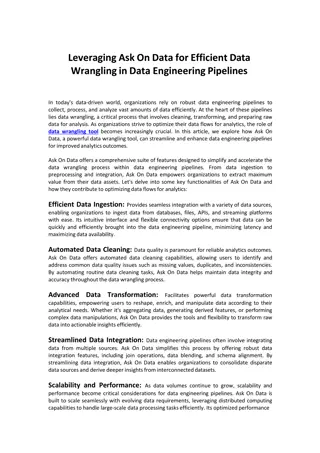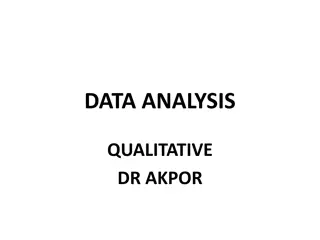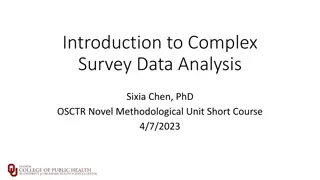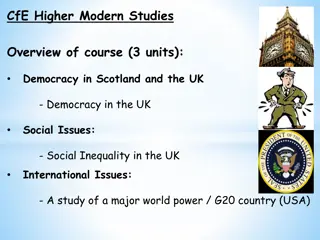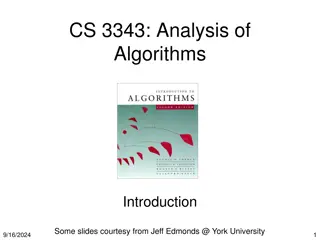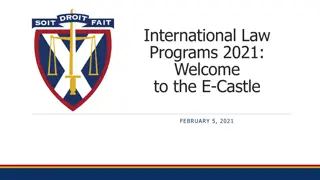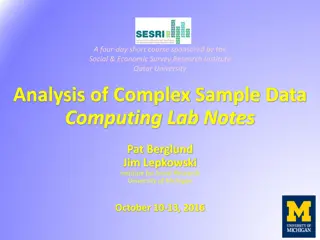International Education Data Analysis Course Overview
An introductory course designed for researchers familiar with basic statistics but new to using international education datasets such as PISA and TALIS. The course includes lectures, practical activities, and computer workshops covering survey design, cross-national comparisons, and data analysis. Participants will gain insights into major education datasets, survey design complexities, and methods of analysis, with a focus on improving research skills in the educational context.
Download Presentation

Please find below an Image/Link to download the presentation.
The content on the website is provided AS IS for your information and personal use only. It may not be sold, licensed, or shared on other websites without obtaining consent from the author.If you encounter any issues during the download, it is possible that the publisher has removed the file from their server.
You are allowed to download the files provided on this website for personal or commercial use, subject to the condition that they are used lawfully. All files are the property of their respective owners.
The content on the website is provided AS IS for your information and personal use only. It may not be sold, licensed, or shared on other websites without obtaining consent from the author.
E N D
Presentation Transcript
Introduction Lecture 1
What this course is about An introductory course . Aimed at researchers with basic stats skills (know about inference, regression) . but have never really used international education datasets Mixture of lectures, practical activities and computer workshops Roughly half of your time will be spent using / analysing the data . Course not just about PISA! Will use data from TALIS also .. .and learn about other international assessments
Structure Four lectures Lecture 1 Types of questions, data available, challenges faced, history and future Lecture 2 How to handle the complex survey design Lecture 3 Nuts and bolts of cross-national comparisons Lecture 4 Test design, plausible values, methods of analysis Four computer workshops Workshop 1 Analysis of TALIS data in a single country (England) using Stata Workshop 2 Testing for significant differences across countries Workshop 3 National and international z-scores Workshop 4 Analysis international assessment data using Stata (focus = PISA)
Day 1 Day 1. 1000-1115. Why do international comparisons (JJ) 1115 - 1145 Coffee break 1145 - 1300. Survey design in PISA (TM) 1300-1400. Lunch. 1400 - 1515. Computer workshop 1 (TM). 1515-1530. Coffee break. 1530-1645. Lecture nuts and bolts of international comparisons (NS)
Day 2 930 1100 Computer workshop 2 and 3 1100 1130 Coffee break 1130 1300 Lecture 4 1300 1400 Lunch 1400 1530 Computer workshop 4 1530 1600 Five things you might not know about PISA .. 1600 1630 Concluding comments / questions
What this course will not cover Not a course about item-response theory (though will touch upon this .) Will not discuss methods for establishing / testing cross-national comparability Will not discuss all the details of the background questionnaire data Focus upon data design and collected to be cross-nationally comparable (e.g. PISA) . not on comparisons between ex-post harmonised data
Aims of the course By the end of the course you should: 1. Know what the major international education datasets are, the type of questions that they can address, challenges researchers face and how they will develop in the future. 2. Understand the complex survey design used, including response rate requirements, national exclusions, cluster sampling, and the purpose and use of replicate weights. 3. Be able to perform basic cross-national comparisons, including formal tests of statistical significance across countries and important methodological issues such as multiple hypothesis testing 4. Understand how PISA / TIMSS test scores are created, and how they can be appropriately analysed using Stata.
What is an international comparison?
What is an international comparison? A comparison of a key feature of a sovereign state to one or more other sovereign states These comparisons come in many shapes and sizes. Examples include - Economic indicators (e.g. Unemployment / GDP) - Human development (HDI index) - Entrepreneurship - Football teams (e.g. FIFA world rankings) - Educational attainment!
Why do international comparisons? (and the type of questions you can answer .
Reason 1: Benchmarking How does the UK perform relative to other countries? This helps us understand our strengths and weaknesses Example: Is income inequality high in the UK? Inequality often measured using something called the GINI coefficient. UK GINI = 0.34 Is this big or small !? Compare to GINI in other countries Give results context Sweden = 0.25 ; Germany = 0.28 ; Australia = 0.30 UK = 0.34 ; US = 0.45 ; Hong Kong = 0.53
Reason 2: Impact of institutions All population exposed to the same institutional structure within a given country. -E.g. Universal healthcare coverage in the UK (NHS) -E.g. Comprehensive education in England Different institutional structures in other countries -E.g. Medical insurance in the US How do these different institutional arrangements impact upon individual s outcomes? -E.g. Children s test scores? ANSWER: Cross-national comparison!
Example: School Tracking Tracking = Separating children into different schools by academic ability Occurs at a young age in certain countries - Germany: Age 10 - Netherlands: Age 12 - Belgium: Age 12 What impact does such tracking have on pupils test scores? Cross-country comparison by Hanushek and Woessmann (2005) - Little impact on average test scores - .but reduction in educational equality NOTE Problem of small n (limited number of countries)
Reason 3: Impact of macro-forces Similar to the institutional structure argument .. There may be certain environmental type factors that influence individual outcomes. These environmental factors may more obviously vary (and potentially have an impact) across countries rather than in countries . Example Income inequality Much attention how this varies between countries (compared to relatively little on regions within countries) . Why? Not sure! More variation across countries? Considered to be a macro/country level force?
Example: The Great Gatsby Curve .6 US Countries with higher levels of income inequality have lower levels of social mobility .. GB .4 Total effect (beta) JP FR KR IE ES Hypothesis Income inequality a macro force that helps to entrench social and economic advantages across generations. IT AU DE CA DK .2 AT FI SE NL BE NO 0 .2 .3 .4 Gini (LIS average) See https://johnjerrim.files.wordpress.com/2013/07/qsswp1418.pdf
Reason 4: Generalise results Does the same social phenomena hold across the world? Much academic research stems from the United States (or based upon US data) ..but do the findings from the US hold in other national settings? Examples Gender gap in reading test scores. Is mother s education more important than father s education for children s test scores? Are children realistic about their chances of completing higher education?
Mother vs Father education and kids test scores Some countries Father education more important .. other countries mother education more important. One finding does not hold everywhere! See http://johnjerrim.files.wordpress.com/2013/07/jj__jm_madison_jan_26_2011_rsf.pdf
Are children everywhere unrealistic about their chances of completing university? Large US literature on how children are unrealistic about chances of completing university .. . But little evidence that this holds everywhere United States is exceptional (rather than generalisable) http://johnjerrim.files.wordpress.com/2013/07/summary_socio_quarterly.pdf
Reason 5: Change in educational standards over time? Long concern in UK regarding the problem of grade inflation Have standards improved? Or have tests got easier? (Or marked more leniently?) International assessments (like PISA) potentially offer an independent benchmark . What the large-scale assessments provide An independent tool (free from national government) to judge change in educational standards over time .. Evidence of whether any given country may be in relative decline . E.g. standards in a country could be going up .. but at a slower rate relative to competitors
But only when conducted robustly http://johnjerrim.files.wordpress.com/2013/07/published_paper.pdf
Reason 6: Politicians / policymakers care! Even if you don t believe the above are important .. other people do! International comparisons tend to have big influence on policymakers -E.g. Heavily cited by Michael Gove (PISA) -E.g. Heavily cited by the White House (Gatsby Curve) -E.g. Popular media (The Spirit Level) Therefore -Important we get them right! -Important we understand what they can (& can not) tell us
Thus to conduct research in this area we require. CROSS-NATIONALLY COMPARABLE DATA And ideally . For a large number of countries . particularly to answer certain questions e.g. role of institutions; impact of macro-forces
What does comparable mean? Survey design (i.e. target population) Response rates (i.e. bias) and weights Same outcome and explanatory variables Consistent definitions Same point in time (e.g. if we think recession has an impact on outcomes .) And much more ..
Cross-national comparability is not easy to achieve, but is fundamental to this type of research. What data has been used in cross-national research? (1) Researcher-harmonised (2) Ex post harmonised (3) Ex ante harmonised
Researcher-harmonised data Take datasets from various countries, that have not been designed with cross-national comparisons in mind, and do the best job we can (1) But really comparable? Different target populations, survey years, response rates, timing of surveys, ordering of questions, variables measures etc If No, then how can we distinguish a genuine difference between countries from the above? (2) The problem of small N (limited number of countries) Despite limitations, used regularly.
Example: Access to elite universities across countries. Use three longitudinal youth datasets Similar designs . Similar ages .. Similar years . But Data not designed to be cross-nationally comparable We have harmonised the data as best we possibly can . See Jerrim, Chmielewski and Parker (forthcoming ..)
Ex-post harmonisation Datasets where a group of individuals have spent significant time and money on making data from different countries as close to comparable as possible after data collection has taken place Examples: Luxemburg Income/Wealth Study CNEF (available from Cornell) + ive: More comparable than being left to individual researchers Large number of countries (big N) - ive: Only a few datasets Unlikely to overcome all the problems discussed
Ex-ante harmonisation Data that has been collected with the specific intention to compare cross-nationally Examples: PISA, PIRLS, TIMSS European Social Survey + ive: Specifically designed to be comparable across nations - ive: Cross-sectional data only Other measurement problems STILL DOES NOT GAURANTEE COMPARABILITY
Focus of this course is upon ex-ante harmonised data
Examples of this type of data PIRLS (10 year olds) TIMSS (10 and 14 year olds) PISA (15 year olds) PIAAC / IALS (Adult competencies) TALIS (International study of teachers) SACMEQ (Southern / East Africa) CIVED (Civic education) ETLS 2017 (Proficiency in English language)
Challenges faced we face when using these data
Comparability Central to everything we are trying to do .. Designing surveys / studies to be comparable helps .. .but does not ensure comparability across countries Some things are just different across countries No matter what we do to try and make them comparable, differences will remain Example: Education / qualification levels ISCED designed to enhance cross-national comparability but qualifications simply are different across countries (see Steadman 2001) E.g. GCSE s in England Fit very poorly into ISCED framework Headache for anyone who has ever used them!!
Causality International assessments = cross-sectional data Mainly used for descriptive / association analysis .. very hard to get causality Issue Knowing causal relationships important if we want to design policy to improve education Some causal work by economists School tracking (Hanushek and Woessmann 2005) School autonomy (Hanushek, Link and Woessmann 2013) My view International assessments are effective benchmarking tools . but not so great at actually identify what countries should do to improve
There are also issues with simply looking at broad cross There are also issues with simply looking at broad cross- -country relationships . country relationships . Relationship between self-efficacy in maths and average PISA scores
There are also issues with simply looking at broad cross There are also issues with simply looking at broad cross- -country relationships . country relationships . Graph shows the relationship between PISA scores and ice- cream consumption per capita. Policy advice ? Eat more ice-cream!
Technicalities Methods used in designing and implementing the international assessments are complex . Notwidely understood .. The psychometric methods used stretch the data to the limit .. Trying to be cutting edge in many areas (test design, sample design, psychometrics, questionnaire design) .. ..puts burden on even secondary analysts to used data correctly Analogy Great Recession of 2008 initially caused by very complex financial tools (derivatives) that very few people in the world could understand and knew how they were created Is the situation with the international assessments (like PISA) that different?
Transparency Certain strengths Most data publicly available and free to download . Now getting huge public / academic scrutiny . .more so than any other dataset I know of International organisations (e.g. OECD) do take criticisms on board and try to improve Many weaknesses Information in technical reports not exhaustive .. Only partial information on how test scores are actually generated .. Test scores are not easily replicable with available public-use data .. . (I am not actually sure it is possible!) International contractors = private firms. No interest in making things open .. Power of any individual country to influence things is very limited
Key point The international assessments strengths and weaknesses . They can help inform education policy . . ..BUT also needs to be considered in relation to wider evidence base!!! Example: East Asian success in PISA To what extent is this due to particular teaching methods in these countries? And should we introduce these here in the UK? PISA alone can not answer this question (actually provides very little insight). FACT: East Asian immigrants to average performing PISA countries (e.g. Australia) do just as well as children in top East Asian countries (e.g. Singapore) EEF RCT of Maths Mastery Provides much more insight into whether introducing East Asian teaching methods into UK schools is a good idea than PISA!
The history of the educational assessments
The history of the educational assessments OECD PISA IEA Science International assessments not new . IEA Literacy But are now Higher quality More countries More regular More impact! IEA Maths 1960 1970 1980 1990 2000 2010 2020 IEA Maths IEA Reading IEA Science OECD PISA
The international studies pre 1990 Not directly comparable with the studies of today. Did not use Item-response theory Not as strict on national representativeness Not as strict on response rates Some recent studies have used these data . E.g. Hanushek and Ludger Woessmann. Cost to low PISA performance across all OECD countries is $100 trillion! E.g. on-going investigations of SES inequality by Chmielewski and Pfeffer But have probably have been under-utilised Caveat = Issues with comparability over time. But still interesting to look at the results .
FIMS (1964) vs TIMSS (2011) 600 Has that much changed over the last 50 years? JP East Asian (e.g. Japan) countries at top of the maths rankings 550 BE NL 2011 (TIMSS) England around the international average FI US EN AU 500 SC SE Sweden does surprisingly poorly IS 450 Cross-country correlation All countries = 0.40 Israel excluded (outlier) = 0.78 15 20 25 30 35 1964 (FIMS)
SIMS (1981) vs TIMSS (2011) 600 HK Has that much changed over the last 25-30 years? JP East Asian (e.g. Japan / Hong Kong) countries at top of the maths rankings 550 BE NL 2011 (TIMSS) England around the international average FI US EN HU 500 NZ SC SE Sweden does surprisingly poorly IS 450 Cross-country correlation All countries = 0.72 Thailand excluded (outlier) = 0.66 TH 35 40 45 1981 (SIMS) 50 55 60 65
Implication Remember that international assessments of children are not new!! Data from these historical studies are available (free) to download: http://www.iea.nl/data.html These data have probably been under-exploited .. Interesting to put the results we see today into a historical context (something which I don t think has been done that much or at least not enough .)
The future of the educational assessments
The move to computer-based testing. PISA 2015 will be done on computers in vast majority of countries Will be linear-progression rather than computer adaptive Many benefits of moving to computer - Time taken to answer questions - Log-files = Every mouse click (how pupils answer questions) - Different types of questions / skills (e.g. interactive questions) - Less question non-response - Test questions tailored to child ability (if/when becomes adaptive ) Issue: Mode effects Change from paper to computer has implications for how we think about trends over time.
Starting to measure student progress. Currently cross-sectional data only = snapshot only .. Real interest is in progress how much do children improve their skills during secondary school? Recognised as important and the future by organisations like the OECD .. .but is a huge administrative burden (very ambitious!) Nevertheless, there is real appetite to start thinking about measures of progress including links to ongoing development of early years assessments (e.g. i-PIPS) Longitudinal PISA studies Some countries already some insight here .. PISA as a baseline for a longitudinal study E.g. Australia, Canada, Czech Republic, Denmark, Uruguay ISSUE Is PISA more relevant as a baseline point or as an outcome point?
Linking to national assessments. Keen interest internationally in links between national assessments and countries own administrative data .. Gives a longitudinal component to the international assessments . E.g. has been used in the US to try and benchmark all states on TIMSS See http://nces.ed.gov/nationsreportcard/studies/naep_timss/ England very well placed here TALIS. Linked in school level information for England. PISA 2015. (Hopefully) linked to NPD data. Unlike other countries, we have very good administrative data .. Unlike other countries, we have test scores between 5 and 16 .. Unlike other countries, we can follow individuals through to at least age 18 .
Broaden global coverage. PISA 2012 = 65 economies Some countries only partially represented (e.g. China only Shanghai) Increase country penetration in the future (PISA and other surveys .) E.g. Five more regions from China participating in PISA 2015 . E.g. Some notable countries (e.g. South Africa) not yet taken part .. PISA for development PISA moving into the developing world . Possible link to post-2015 Millennium Development Goals (MDG) Planned attempts to test both the school population and children who are not attending / enrolled (important but a challenge) .. Purpose Post 2015 MDG to focus on outcomes in terms of skills (rather than inputs).





